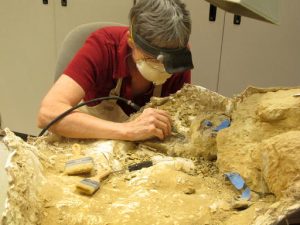
Jack Horner, the paleontologist who discovered the world’s first dinosaur embryos and found that dinosaurs had nests and cared for their young, is leaving the Montana museum he spent decades filling with fossils from across the globe.
Horner, 69, Is one of the best known dinosaur researchers in the world. Michael Crichton based the character Alan Grant on Horner in the 1990 book “Jurassic Park,” and Steven Spielberg brought Horner on as a technical adviser on all of the “Jurassic Park” movies—and Horner did it without a college degree and with dyslexia.
From his base at the Museum of the Rockies in Bozeman, and before that with Princeton University, Horner discovered a dozen dinosaur species, the first dinosaur eggs in the Western Hemisphere, and provided proof of the theory of their close relation to birds. He built the Museum of the Rockies from eight dinosaur specimens when he started working there 34 years ago to more than 35,000 today.
As he ponders a state of semi-retirement, he plans to turn his attention back to education by teaching a class on imagination and creative thinking at Chapman University in California.
His struggles with dyslexia caused him to flunk out of college multiple times and initially hindered his ability to raise money for research because the grant applications had to be signed by an advanced-degree holder. He still reads at a third-grade level, and claims to have written more books than he’s read.
Horner solved one funding crisis by seeking $10,000 from the Ranier Brewing Company, whose beer he and his team drank. Princeton, his employer at the time in the late 1970s, balked and gave him the money instead.
“So Ranier Brewing Company gave us 100 cases of beer for the summer,” he said in a recent interview with The Associated Press.
That summer in 1979 would result in one of his most important discoveries—dinosaur nests on what was later called Egg Mountain in Montana. He found the site less than a mile from where he had discovered the fossils of young dinosaurs a year earlier.
“That one square mile out there is the richest dinosaur site in the world,” he said.
Little was known then about juvenile dinosaurs, and with the finds, Horner’s career path was set. The money came pouring in from the National Science Foundation and from other grants. The head of the Museum of the Rockies, tired of seeing Horner take the valuable specimens out of Montana, hired him as the museum’s paleontologist.
After that, Horner led as many as nine crews in a single digging season from Montana to Mongolia, and he started building what would become one of the largest tyrannosaurus rex and triceratops collections in the world.
Horner for the last several years has been working on the chickenosaurus, or dino-chicken. His idea is to revive dormant dinosaur DNA found in chickens to give them some traits of their ancestors, such as a long tail.
Horner said work continues on that project, and he will likely set up a laboratory for it in California, but his focus is being pulled to other things, as well. He has five books in the works, including an autobiography. He said he is helping Microsoft develop an app, but declined to speak about it in any detail.
He also won’t give up dinosaur hunting. The University of Washington is planning to open its new Burke museum, and Horner has agreed to be a part-time research associate to help fill the museum up with dinosaurs.
The Museum of the Rockies is overflowing with dinosaur fossils after 34 years of Horner as its curator of paleontology. A planned expansion will allow the museum to bring its vast collection under one roof, but there won’t be any room for him to bring in anything new to work on, he said.
“I filled this place up. There’s no reason to just stay,” Horner said. “I would just be—what do you call it—resting on your laurels or something?”
The Museum of the Rockies, which is a part of Montana State University, hasn’t found a new curator yet. Members of Horner’s team who will remain in Bozeman say he will be difficult to replace, but the museum is strong enough now to stand on its own.
“We may have a lag while we get re-established with a new curator, but I don’t see us diminishing and going away,” said Jamie Jette, who worked with Horner for 18 years.
For his part, Horner is most interested in applying his approach to paleontology to the education system. He made his most famous discoveries because he was unafraid to take a hammer to a dinosaur egg when everybody else thought eggs were too precious to crack, he said.
“I made a discovery because I had a hammer,” Horner said. “That kind of thinking is basically what I made my career on.”
Note: The above post is reprinted from materials provided by The Associated Press.










